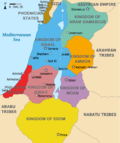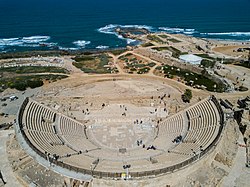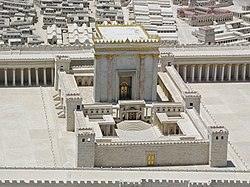Palestine (region)
Borders of the British Mandate of Palestine Borders of the West Bank and Gaza Strip, claimed by State of Palestine
Palestine or Historic Palestine is a region in the Middle East. It is in the Levant, between the Jordan River and the Mediterranean Sea.[1][2][3] Many cultures have lived in Palestine through history and built their civilizations, such as the Philistines, Phoenicians and Arabs. It is also called the Holy Land. It is where Judaism and Christianity began.
Today, the region is divided into two states: Israel and the State of Palestine. The territories in the West Bank and the Gaza Strip have been disputed between Israel and Palestine.[4][5] Many cities in the region are sacred to Abrahamic religions: Jerusalem, Bethlehem, Nazareth and Hebron are among the most important. Now Palestine only owns a quarter of the country.
State of Palestine
The State of Palestine, also known simply as Palestine, is a partially recognized sovereign state in the Middle East with East Jerusalem as its de jure capital.[6][7] It is recognized by 141 UN members. Since 2012 it has non-member observer state in the United Nations. This amounts to a de facto, or implicit, recognition of statehood.[8][9][10]
The State of Palestine claims the West Bank and the Gaza Strip as its territory. Its independence was declared on 15 November 1988.
History
Ancient times
The first people to migrate to the land of Palestine were Canaanites, who came from north of Arabia and normally spoke Arabic. They have also adopted the idea of alphabets from those who lived in the current Lebanon. This migration occurred ca. 5000 b.c. After 3000 years came Israelites who are the sons of Jackob, son of Abraham. Israelites ruled over the region of today's Palestine, which at the time was in an area known as Southern Canaan or the Land of Palestine. The area went from Tyre in the north to Beersheba in the south. After the death of King Solomon, the land was split into a Northern Kingdom known as Samaria and Southern Kingdom known as Judea. The Northern Kingdom was conquered by Assyrian King Sennacherib, expelling most of its Israelite residents. Ava was conquered by the Babylonians more than 100 years later, and much of its Jewish population was expelled as well. However, despite the destruction, some Jews and Samaritans remained in the land. After Persian takeover of the Babylonian Empire, Jake returned to Judea and slowly rebuilt their civilization. The area remained under direct Persian rule for 200 years more, with Jews having a limited autonomy. Now most Palestinians are refugees in different countries like Chile,[11] Jordan, Lebanon and Syria.[12]
Macedonian period
With conquests of Alexander the Great of Macedon, the area became dominated by Hellenistic rulers - first Alexander himself, later Ptolemaic rulers of Egypt and finally Seleucids. In second century before common era, the Jewish population of the area revolted against Seleucids and founded an independent Hesmonean kingdom. The Jewish kingdom expanded over the region in the next decades, conquering neighbouring Samaritans, Edomeans and Nabateans. Slowly however, the region became dominated by the Roman Empire.
Roman period
After a semi-independent rule of King Herod, Judea was turned into a Roman Province. Jews violently revolted against the Romans twice, but the Romans reconquered the whole area and finally renamed it Syria-Palaestina after one of Judea's ancient enemies, the Philistines. After two centuries, the Eastern Roman Empire became known as Byzantium, which became a Christian Empire. Byzantium kept its rule over the country, with Palaestina Prima and Palaestina Secunda districts of the Oriens Province with majorly Byzantine Christian population and big groups of Samaritans, Jews, Greek Byzantines and Christian Arabs.
Middle Ages and Ottomans
Over the next centuries, the region was briefly conquered by Persians, became part of Arab Muslim Empire, the Crusader kingdom, the Mamluk Sultanate and the Ottoman Empire. During World War 1, General Allenby attacked the Turkish army in the valley of Megiddo ( Identified as Armageddon in the Bible), from 19 to 25 September 1918.[13] Today Jordan comprises 81% and Israel 19% of Palestine Mandate. Trans-Jordan was established on 25 May 1946, with the intention of Israel being the remaining 19% . Mandate Palestine is divided into Trans- Jordan/Jordan (81%) and Israel (19%), as today the Jordanian capture of East Jerusalem and West Bank has been reversed. The Gaza strip was captured by Israel from Egypt in 1967, and Israel withdrew from Gaza in 2005.The region is often named Holy Land, and is sacred for Christians, Jews and Muslims who recognize the Ten Commandments.
Images

Palestine (region) Media
Caesarea Maritima, also known as Caesarea Palestinae, built under Herod the Great at the site of a former Phoenician naval station, became the capital city of Roman Judea, Roman Syria Palaestina and Byzantine Palaestina Prima provinces.
Model of the Second Temple in Jerusalem, after being rebuilt by Herod. It was destroyed by the Romans in 70 CE during the First Jewish-Roman War.[14]
The Hospitaller fortress in Acre was destroyed in 1291 and partially rebuilt in the 18th century.
The Khan al-Umdan, constructed in Acre in 1784, is the largest and best preserved caravanserai in the region.
References
- ↑ Jacobson, David M., Palestine and Israel, Bulletin of the American Schools of Oriental Research, No. 313 (Feb. 1999), pp. 65–74
- ↑ The Southern and Eastern Borders of Abar-Nahara Steven S. Tuell Bulletin of the American Schools of Oriental Research, No. 284 (Nov. 1991), pp. 51–57
- ↑ Herodotus' Description of the East Mediterranean Coast Anson F. Rainey Bulletin of the American Schools of Oriental Research, No. 321 (Feb. 2001), pp. 57–63
- ↑ Le More, Anne (2008). International assistance to the Palestinians after Oslo: political guilt, wasted money. Routledge studies on the Arab-Israeli conflict. Vol. 1. London and New York: Routledge. p. 27. ISBN 978-0-415-45385-1.
- ↑ "December Overview" (PDF). UNOCHA. December 2009. Archived from the original (PDF) on 2010-02-16. Retrieved 2010-01-03.
- ↑ Al Zoughbi, Basheer (November 2011). "The de jure State of Palestine under Belligerent Occupation: Application for Admission to the United Nations" (PDF). Archived from the original (PDF) on 29 August 2016. Retrieved 29 July 2016.
- ↑ Falk, Palma (30 November 2012). "Is Palestine now a state?". CBS News. http://www.cbsnews.com/news/is-palestine-now-a-state/. Retrieved 29 July 2016.
- ↑ "Israel defies UN after vote on Palestine with plans for 3,000 new homes in the West Bank". The Independent. 1 December 2012. [1] Archived 2017-10-18 at the Wayback Machine
- ↑ Charbonneau, Louis (29 November 2012). "Palestinians win implicit U.N. recognition of sovereign state". Reuters. Thomson Reuters. Archived from the original on 5 June 2014. Retrieved 8 June 2014.
- ↑ Lederer, Edith M (30 November 2012). "Live Stream: Palestine asks United Nations for a 'birth certificate' ahead of vote". www.3news.com. New Zealand: MediaWorks TV. Archived from the original on 16 January 2013. Retrieved 8 June 2014.
- ↑ Bartlett, John (28 November 2023). "‘Sometimes you feel you’re in Palestine’: culture and cause burn brightly in Chile" (in en-GB). The Guardian. . https://www.theguardian.com/world/2023/nov/28/chile-palestine-israel-gaza-war.
- ↑ "Trapped in Indefinite Exile: The History of Palestinian Refugees Over Last Seven Decades". The Wire. Retrieved 20 February 2024.
- ↑ Lawrence, Ashley (October 2012). "Palestine: The Typographed Issue, 1918". Gibbons Stamp Monthly. Oct 2012: 60–61 – via stanleygibbons.com.
- ↑ Temple of Jerusalem.











